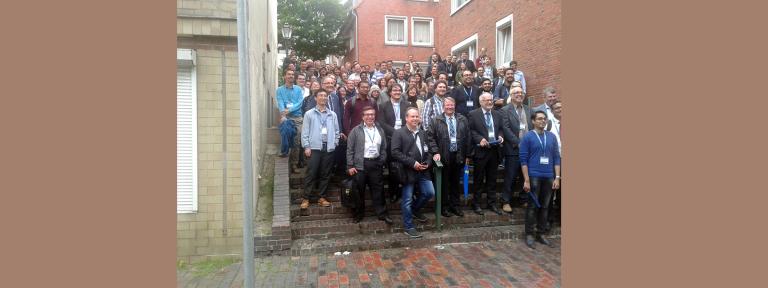
“The most important thing is the car gets the message in real-time.”
Dr. Juan Pimentel led a tutorial on connected vehicles and presented a recent publication on wireless sensor networks from July 24-26 at the IEEE 15th annual International Conference of Industrial Informatics in Emden, Germany.
The tutorial focused on vehicle-to-vehicle and vehicle-to-infrastructure communications using wireless technologies. Based on this type of communications, the vehicle would be capable of making decisions about stimuli that extend beyond a driver’s range of vision.

“The idea is that the vehicle can use wireless communications to communicate with other vehicles and infrastructure,” Pimentel said. “This really makes sense because sometimes you don’t see two or three vehicles down the road.”
The result of this technology can reduce issues related to traffic, accidents and other emergencies. For example, if a car suddenly changes lanes 100 meters ahead beyond the driver’s line of sight, the vehicle itself would be able to wirelessly detect this shift and adjust speed, path and direction accordingly to avoid a ripple effect of the poor decision ahead.
“The most important thing is the car gets the message in real-time,” Pimentel said.
According to Pimentel, vehicles are currently being developed in the United States that utilize this technology. He believes that this technology will become common in all vehicles within the next five years.
In order to prepare for this technology, Pimentel is embarking on a new research project that will examine whether this will truly enhance safety. He will attempt to examine hazards -- such as a driver suddenly changing lanes -- and then determine by what degree vehicle-to-vehicle communications can reduce the risk of accidents resulting from a threat.
Pimentel, professor of Computer Engineering, has been actively researching safety of automotive systems since 2002 but has recently applied his research to autonomous vehicles. In August 2017, the Institute of Electrical and Electronics Engineers (IEEE) Intelligent Transportation System Magazine accepted his article titled "System Safety Architectures for Autonomous Vehicles." His recent foray into autonomous vehicle technology presents a unique challenge.
“Autonomous problems are different because they are external to the car, not internal,” Pimentel said. “The research methodologies are the same but the details are totally different.”
Pimentel utilized over 15 years of research experience in wireless communications to create an independent study a new course titled “Wireless Communication and Networks” (CE-591). The class was first offered in Spring 2017 and will be offered again next year. The class covers the fundamentals of wireless communications and then potentially apply it to autonomous technology projects. The class is recommended to Kettering students who are involved with the AutoDrive Challenge on campus.
In addition to the tutorial, Pimentel, along with collaborators at the Instituto Peruano de Energía Nuclear in Lima, Peru presented their recently published paper titled: “Energy Optimization of an Experimental Wireless Sensor Network for Remote Areas.” The paper focuses on sustaining wireless networks in rural and remote areas that have limited or no access to electricity and WiFi.
“I’ve been doing research on automotive safety critical systems and wireless communications for several years,” Pimentel said. “Now, with autonomous vehicles it’s a little bit different, but it’s not too much of a stretch to get into it.”